
What is peyote and why do people use it?
Curious about peyote? Learn about the history, origins, and use of the mescaline cactus below. From ancient American tribes to modern-day rituals, peyote continues to play an important role in human spirituality.
Peyote is more than just a cactus: it’s a gateway to the world of psychedelics and spirituality. With deep roots in ancient tradition, peyote has long helped humans expand their consciousness and spiritual insight with its powerful psychedelic effects.
A staple of ancient rituals, the peyote cactus (Lophophora williamsii) hasn’t lost its place in the world. Nonetheless, its use is often misunderstood, which is why we created this guide: to shine a light on the peyote plant, its history, effects, cultivation, and legal status.
Note that this article won’t cover specific information on how to grow peyote, consume it, or the nature of peyote rituals. Make sure to check out our dedicated blogs for more info about these topics.
What is peyote?
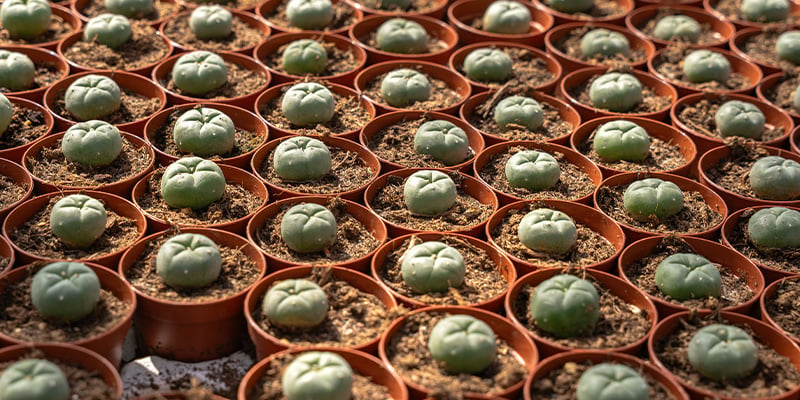
So, what is the peyote drug? Peyote refers to Lophophora williamsii, a small, round, and spineless cactus species native to Mexico (particularly the Chihuahuan desert) and the Southwestern United States. Its "drug-like" effects come from its rich concentration of mescaline, a natural hallucinogenic compound that gives peyote its unique effects. Note that there’s a difference between mescaline vs peyote: the former is a chemical while the latter is a plant.
Though every user's experience with mescaline is different, it’s known to produce a deeply introspective psychedelic experience with intense visual hallucinations. Mescaline isn’t considered addictive, in part because users quickly develop a tolerance to it, even after just a few days of repeated use.
If you’re wondering where to buy peyote, we’ll cover that in more detail below. However, you can also grow peyote at home in places where it's legal. In fact, peyote cultivation is very popular, and you can learn more about it in our dedicated guide.
What does peyote look like?
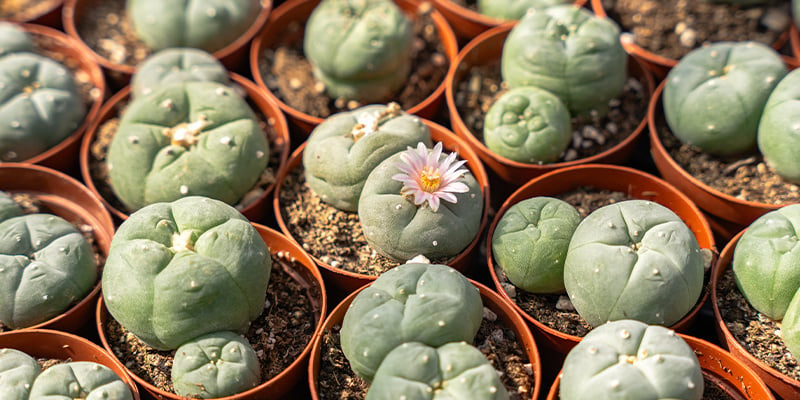
What does a peyote plant look like? Sometimes called peyote buttons because of their short, stout shape and structure, the Williamsii peyote cactus is small and dome-shape with a blue-green or greyish colour and fuzzy tufts that form at the areoles. Peyote plants don’t usually grow taller than 7 cm, and reach 4–12 cm in diameter.
Unlike the San Pedro cactus, which has prominent spines, peyote is completely spineless. The peyote plant can also bloom sporadically, forming fast-growing pink or white flowers at the apex that can produce pink fruit with flat black seeds.
Some common identifiers of peyote include:
- Short, rounded, button-like appearance
- Blue-green or grey-green colour with a smooth, waxy surface
- No spines.
- Tufts of white, woolly hair at the areoles
The effects of peyote
As mentioned, mescaline (3,4,5-trimethoxyphenethylamine) is the chemical primarily responsible for peyote's psychedelic power.
With a chemical structure similar to that of neurotransmitters like dopamine and serotonin, mescaline primarily acts as an agonist of the 5-HT2A serotonin receptor (the same receptor targeted by LSD and psilocin). As a result, users may experience visual or auditory hallucinations and intense emotional responses.
The peyote drug experience (like any psychedelic experience) can vary. Some people may have deep spiritual insights; others may feel a long-lasting euphoria, and others still may experience unpleasant trips marked by intense anxiety and fear. Dose, set, and setting are some of the biggest factors influencing how a person will react to peyote.
As the trip wears off, it’s common for users to experience fatigue, emotional sensitivity, and spiritual insights. To make the most of these insights, experienced peyote users and psychonauts recommend journalling after a psychedelic trip.
Note that while psychonauts often compare peyote vs ayahuasca, these substances are very different. You can learn more about ayahuasca and its effects in our article.
Short-term effects (during the trip):

Peyote's effects typically have an onset of 30–120 minutes. They peak after 2–4 hours, and may last up to 12 hours. At its peak, the peyote experience is characterised by:
- Vivid visuals, both with open and closed eyes
- Changes in perception of time and space
- Introspection or euphoria, depending on the individual
- Enhanced sensory sensitivity and a heightened response to sound, colour, and touch
- Deep personal or spiritual insights
Long-term effects (post-experience integration)

As mentioned earlier, while the psychedelic experience induced by peyote drugs might wear off in a matter of hours, the after-effects can be felt for days or even weeks after a trip. Again, this varies from one person to another, but some common long-term peyote effects users report include:
- Enhanced mood or emotional regulation
- Increased introspection
- Reduced anxiety
- Positivity
Physical side effects
While psychedelic users are quick to mention the benefits of peyote, ingesting the cactus also commonly induces some unpleasant (generally not dangerous for most individuals) side effects. Depending on the dose and the individual, these may include:
- Nausea and vomiting (common and often interpreted as a form of cleansing or pre-trip purge)
- Increased heart rate and blood pressure, especially during the initial onset
- Dizziness, sweating, or chills
- Tremors or muscle tension
- Loss of appetite
- Dry mouth
The risks of peyote

Though perhaps not addictive, it’s important to realise that taking peyote does come with psychological and emotional risks (just like any other psychedelic).
The greatest risks of using peyote arise for people with a history of mental health conditions. There’s also evidence to support that psychedelic drugs like mescaline may trigger mental health disorders in individuals with a predisposition to these illnesses (Simonsson et al., 2023). In general, people with a history of psychosis, schizophrenia, and bipolar disorder should steer clear of psychedelics, including peyote.
Of course, people taking medications that affect serotonin or serotonin receptors (such as selective serotonin reuptake inhibitors or monoamine oxidase inhibitors) should also avoid using peyote and psychedelics in general.
Remember, mescaline trips can be marked by moments of anxiety, confusion, disorientation, or even full-blown panic attacks. For some people, psychedelics may bring to surface past traumas; others may simply become acutely aware and sensitive to their thoughts and memories.
To help minimise the risks when taking peyote, keep the following simple harm-reduction tips in mind.
- Pay close attention to your set (state of mind in the weeks, days, and hours approaching a trip).
- Consider your setting (the environment you’ll be tripping in) and prepare it accordingly.
- Consider a trip sitter, i.e. a trusted guide, preferably with some experience taking psychedelics, to accompany you on your trip.
- Consider your diet in the days leading up to your trip. Psychonauts often prefer eating light, raw meals and minimising their intake of meat, dairy, junk food, and alcohol before tripping.
- Rest up. A good sleep routine is vital for overall health and prepping for a psychedelic journey.
The history and cultural significance of peyote
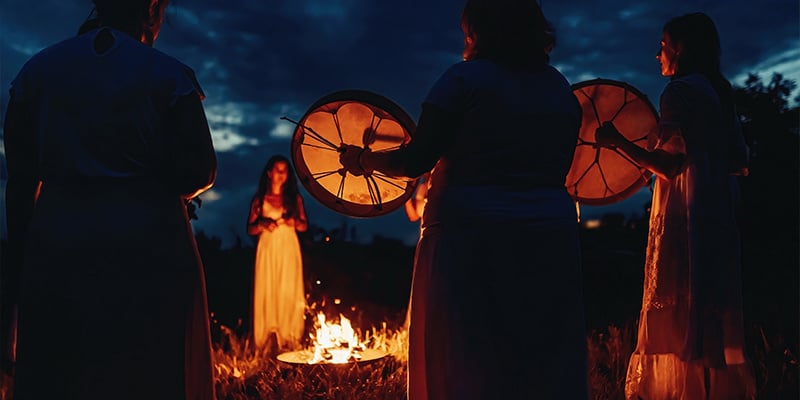
Peyote has been central to certain cultures for thousands of years, especially among tribes native to modern-day Mexico and the southern USA. In the 1930s, archaeologists recovered peyote specimens from caves located along the US-Mexico border dating back over 5,000 years (Terry et al., 2006). Similar research at Coahuila, Mexico, uncovered peyote specimens dating back to 1070 CE.
But don’t be fooled into thinking that peyote ceremonies are a thing of the past. The Native American Church continues to hold peyote rituals that aim to preserve the ancient use of this plant. While individual ceremonies may vary, they often feature the following core tenets:
- Rituals are often held overnight in tipis or similar traditional structures.
- They may feature prayers, drumming, and singing.
- These experiences are guided by a shaman or roadman, who helps participants through their psychedelic experience.
- Peyote rituals often centre on healing, spirituality, and strengthening community bonds.
In some regions, the religious or ceremonial use of peyote is even protected by law. The 1994 American Indian Religious Freedom Act Amendments, for example, explicitly legalized the use, possession, and transportation of peyote by members of recognised Native tribes (Vile, 2009). The US DEA also exempts the use of peyote at Native American Church ceremonies from penalties outlined in the US Controlled Substances Act (The Peyote Way Church, n.d.).
The legality of peyote
Where is peyote legal? As is often the case with psychedelics, the answer is complex and varies from one region to another. In the US, for example, peyote is illegal under the Controlled Substances Act, though there are exemptions for members of federally recognised native tribes.
In Mexico, Peyote is protected under cultural heritage laws, and some indigenous groups have legal rights to cultivate and use it for ceremonial purposes. In the rest of the world, peyote and mescaline are generally illegal. If you plan to cultivate peyote, make sure to research whether the peyote cactus is legal where you live.
What is peyote cactus: A sacred plant with modern relevance
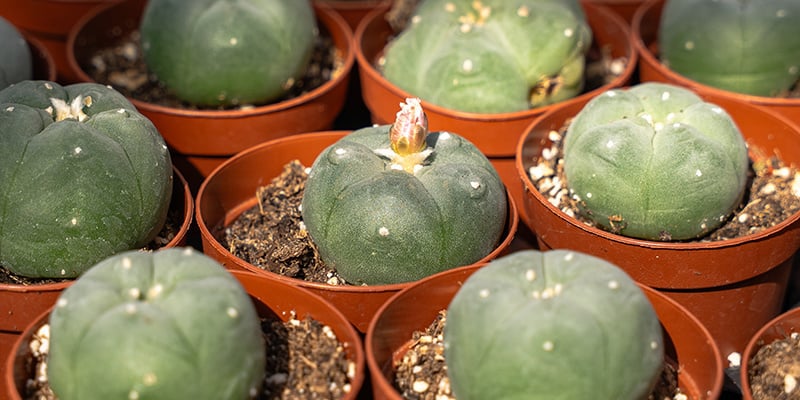
Now, when someone asks you, “What’s peyote?”, you'll be able to confidently provide them with an answer. Knowing what the peyote plant looks like will help you identify and distinguish it from other species, and understanding its effects will help you decide whether it’s right for you. Finally, recognising the differences between ayahuasca vs peyote and other psychedelics can further help put each plant’s effects in perspective.
If you do decide to explore the fascinating world of peyote and mescaline, Zamnesia’s select range of peyote cacti and other products offers a trusted, ethical, and legally compliant entry point. Make sure to check out the Zamnesia peyote product range here or explore our peyote consumption guide to learn more about using this powerful psychedelic cactus.
- Simonsson, Otto, Goldberg, Simon B., Chambers, Richard, Osika, Walter, Simonsson, Charlotta, Hendricks, & Peter S. (2025, July). Psychedelic use and psychiatric risks - https://link.springer.com
- Terry, M., Steelman, K. L., Guilderson, T., Dering, P., & Rowe, M. W. (2006/07/01). Lower Pecos and Coahuila peyote: new radiocarbon dates - https://www.sciencedirect.com
- The Peyote Way Church of God. ((n.d.)). Legality of Peyote « The Peyote Way Church of God - https://peyoteway.org
- Vile, & J. R. (2009, January 1). Free Speech Center at MTSU - https://firstamendment.mtsu.edu
-
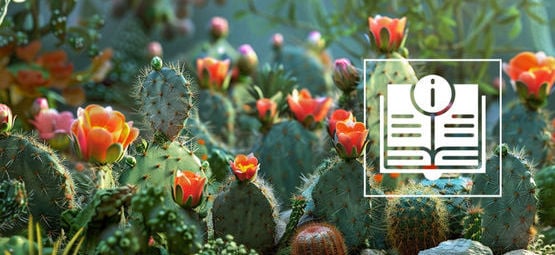 6 min
11 July 2024
The Ultimate Mescaline Cactus Guide
Mescaline is a time-honoured but often misunderstood drug. Here we aim to demystify it somewhat, and give a general overview of everything you need to know about mescaline cacti!
6 min
11 July 2024
The Ultimate Mescaline Cactus Guide
Mescaline is a time-honoured but often misunderstood drug. Here we aim to demystify it somewhat, and give a general overview of everything you need to know about mescaline cacti!
-
 5 min
27 November 2019
How To Grow Your Own Mescaline Cactus From Seed
Mescaline is a natural psychedelic produced by several types of cactus including peyote, San Pedro, and the Peruvian torch. These cacti are easy enough to grow, even if you don't have a lot of...
5 min
27 November 2019
How To Grow Your Own Mescaline Cactus From Seed
Mescaline is a natural psychedelic produced by several types of cactus including peyote, San Pedro, and the Peruvian torch. These cacti are easy enough to grow, even if you don't have a lot of...
-
 3 min
6 October 2018
Top 5 Mescaline Cacti
Mescaline occupies the esteemed podium of naturally occurring hallucinogens along with DMT and psilocybin. The alkaloid can be found in a variety of cactus species. Here are the top 5...
3 min
6 October 2018
Top 5 Mescaline Cacti
Mescaline occupies the esteemed podium of naturally occurring hallucinogens along with DMT and psilocybin. The alkaloid can be found in a variety of cactus species. Here are the top 5...
-
 3 min
2 June 2017
Mescaline Cacti Differences
Mescaline is a psychoactive compound found in several species of cacti. Each species provides its own interpretation of the mescaline experience. How do the effects differ from species to species?...
3 min
2 June 2017
Mescaline Cacti Differences
Mescaline is a psychoactive compound found in several species of cacti. Each species provides its own interpretation of the mescaline experience. How do the effects differ from species to species?...





 United States
United States











